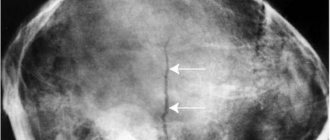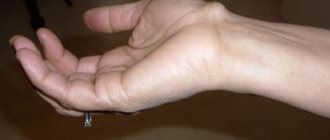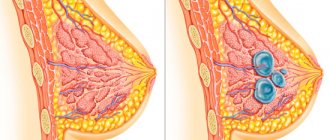Weakness of labor is insufficiently strong contractions that do not lead to the opening of the cervix and the baby moving towards the exit. The most commonly diagnosed abnormal labor in women is:
- With endocrine diseases in the pregnant woman herself (obesity, diabetes, hypothyroidism and other pathologies).
- In case of excessive stretching of the myometrium during gestation, due to which it subsequently cannot perform its main functions (in case of multiple pregnancy, polyhydramnios, with an expectedly large child).
- Having undergone various pathological processes in the uterus and surgical interventions (for example, cesarean section, removal of nodes, etc.);
- With malformations of the uterus - bicornuity, presence of a septum, etc.
- Age up to 18 years and after 35.
An important role is given to the psycho-emotional state of the woman, as well as her readiness for labor.
Primary weakness of labor is established if contractions were initially weak, sluggish, and unproductive. As a rule, some time is given for the development of active labor - about 3-5 hours. Signs of weak contractions:
- they are short, less than 20-30 seconds, and not strong, which even the woman herself can note;
- Dynamic vaginal examination does not reveal any opening of the cervix.
Secondary can occur at any time during childbirth. It is established if, up to a certain point, uterine contractions were effective and brought results (the opening of the cervix was stated, the fetus was moving towards the exit), and after that their intensity slows down, the whole process is suspended.
Secondary weakness often results from:
- overwork of a woman, for example, if labor lasts more than 5-7 hours or the previous night it was not possible to get enough sleep for some reason;
- if at the beginning of labor the contractions were very painful and no attempts were made to soften them, the woman in labor becomes tired not only mentally, but also physically.
Weakness of pushing refers more to secondary weakness, but can also be caused by primary weakness of labor. In this case, the woman cannot push even when the uterine pharynx is fully open, or the uterus has to wait a long time for contractions, which can affect the condition of the child.
Weakness of pushing is also a consequence of poorly developed abdominal, pelvic, diaphragm muscles and simply the woman’s fatigue.
With primary weakness, the woman behaves calmly , notes that the contractions are weak, she may even be pleased that she tolerates the entire birth process so well. If you place your hand on your stomach and thus calculate the duration of contractions and their frequency, it becomes clear that there is a weakness of the labor forces.
With secondary weakness, women are more often exhausted from previous hours of work , they want to sleep, lie down, rest, are lethargic, react poorly to others and all attempts at verbal help.
Diagnosis of the pushing condition:
- Intensity of uterine contraction. Used for pre-diagnosis and monitoring of a woman’s condition. In this case, the doctor, simply placing his hand on the woman’s stomach in the area of the fundus of the uterus, records the time after which contractions begin and their duration. If they are not strong enough, other methods are additionally used.
- Cardiotocogram recording . A special uterine sensor is used, which is installed in the fundus of the uterus and records the strength and frequency of contractions, while recording a graph. By the amplitude and time interval between contractions, one can judge how effective labor is.
- Dynamics of cervical opening and fetal advancement . This method is considered the most reliable indicator, as it reflects how effectively childbirth is going overall. To determine the rate of cervical dilatation, a dynamic vaginal examination is performed every 6 hours. In this case, the opening should increase by 3-4 cm. If this does not happen, the contractions are weak.
- Weakness is also established if the cervix has a good opening (10-12 cm), but the fetus does not advance, and there is not enough strength of contractions.
Treatment of weakness of labor:
- Carrying out an amniotomy . If a woman in labor experiences weak contractions and the water has not yet poured out, it is necessary to artificially open the membranes. After most of the amniotic fluid is released, the uterine cavity will contract, this will give impetus to intensifying labor contractions. This is the most natural option.
- Medication sleep. It is usually prescribed if a woman is tired (for example, the day before she was tormented by pathological precursors of labor, or she has been in labor for many hours). Antispasmodic drugs, sedatives, and strong painkillers (often narcotic) are prescribed. After this, the woman enters a state of half-asleep for 2-3 hours, which subsequently helps her feel better and the contractions become stronger.
- Administration of drugs that increase uterine contractions. Can be prescribed at any stage of labor. Oxytocin is most often used intravenously. Depending on the obstetric situation, prostaglandins are used intravenously, as well as other groups of drugs (“Mifepristone”, “Desaminooxytocin”, etc.). After this, another 3 hours are given for the development of regular and productive contractions; if treatment is weak, a cesarean section is usually necessary.
- Applying a vacuum extractor or forceps . It is used when pushing is weak, when it is too late to perform the operation due to the child’s position being too low.
- Performing a caesarean section. It is the final stage in the treatment of weak contractions when other methods are ineffective. Often, caesarean sections are performed after many hours of testing, after all conservative methods have been applied.
Danger to child and woman:
- The occurrence of fetal hypoxia . Possibly at any stage of labor. At the same time, smaller portions of oxygen begin to flow to the baby, which is why he experiences severe stress. Timely performance of an operation or acceleration of labor by administering various stimulating drugs is the prevention of child disability.
- Trauma to the birth canal for a woman. If the baby remains in one position for a long time even as it moves through the birth canal, this leads to compression of the mother’s tissues between the baby’s skull and pelvic bones. Subsequently, this causes disruption of the bladder, tissue necrosis and the formation of fistulas.
Measures to prevent weakness of labor:
- Preparing for childbirth: attending courses, seminars, getting to know the maternity hospital and the doctor.
- Correct establishment of labor management tactics even before the onset of contractions, as well as identification of deviations in the early stages.
- Competent management of childbirth.
Even during pregnancy, groups of women are identified who have an increased risk of developing anomalies during childbirth. They need closer attention.
Read more in our article about weakness of labor.
Causes of weakness of labor
The causes of any type of weakness can be various factors or a combination of them. The most commonly diagnosed abnormal labor in women is:
- With endocrine diseases in the pregnant woman herself. For example, obesity, diabetes, hypothyroidism and other pathologies.
- When the myometrium is excessively stretched during pregnancy, due to which it subsequently cannot perform its main functions. This is possible with multiple pregnancies, polyhydramnios, or with a supposedly large baby.
- When undergoing various pathological processes in the uterus, surgical interventions (for example, cesarean section, removal of nodes, etc.);
- For malformations of the uterus: bicornuity, presence of a septum, etc.
- More often, weakness of labor is observed in women under 18 years of age and after 35.
Expert opinion
Daria Shirochina (obstetrician-gynecologist)
An important role is given to the psycho-emotional state of the woman, as well as her readiness for labor. Therefore, during pregnancy, you need to find out in detail what lies ahead, what actions are important for the mother in labor, and what to expect from the medical staff.
Reasons for the development of pathology
The causes of abnormal birth can be very different. They are conventionally divided into groups:
- pathologies of the mother’s nervous system (stress, depression, various mental disorders). It has been noticed that if a woman is very afraid of childbirth, then, as a rule, it occurs later and occurs with anomalies;
- general disorders of the body (diabetes mellitus, thyroid pathologies, obesity, chronic diseases, overwork, diseases resulting from alcohol abuse and drug use);
- problems with the reproductive organs (uterine scar, chronic gynecological diseases, late onset menstrual bleeding, irregular menstrual cycle, physiological abnormalities of the anatomical structure of the uterus);
- complications of pregnancy (gestosis, developmental abnormalities and malpresentation of the fetus, post-term and prematurity, low location or premature aging of the placenta, early rupture of amniotic fluid, unpreparedness of the cervix for childbirth);
- overstretching of the uterine muscles (polyhydramnios, multiple pregnancies, large fetuses, previous abortions, since curettage leads to thinning of the muscle layer);
In multiple pregnancies, complications and labor anomalies often occur.
- physiological characteristics of the woman and child (insufficiently wide maternal pelvis, incorrect insertion of the fetal head, tumors of the pelvic organs).
The following can also lead to various pathologies:
- pain during childbirth, which depletes a woman’s nervous system. Therefore, doctors should provide pain relief in a timely manner, if necessary;
- the use of drugs that enhance uterine contractility (Oxytocin and similar substances). When introducing them, you need to remember the dosage, moment and speed of administration;
- delayed opening of membranes.
Video: causes of labor anomalies
Types and their features
Weakness of labor is insufficiently strong contractions that do not lead to the opening of the cervix and the baby moving towards the exit. Depending on the pace and timing of development, several options are distinguished.
Primary
It is established if contractions were initially weak, sluggish, and unproductive. As a rule, some time is given for the development of active labor, about 3-5 hours, it all depends on what stage the woman in labor is at. Signs of weak contractions:
- they are short, less than 20-30 seconds, and not strong, which even the woman herself can note;
- During a dynamic vaginal examination, the opening of the cervix is not detected, that is, the contractions are non-productive.
Secondary
Can occur at any time during labor. It is established if, up to a certain point, the contractions of the uterus were effective and brought results (the opening of the cervix was stated, and the fetus moved towards the exit), and after that their intensity slows down, the whole process is suspended.
Secondary weakness is often the result of a woman’s overwork, for example, if labor lasts more than 5-7 hours, or for some reason she was unable to get enough sleep the previous night. It can also occur if at the beginning of labor the contractions were very painful and no attempts were made to soften them, the woman in labor becomes tired not only mentally, but also physically.
Watch this video about the causes of weak labor:
Weakness of pushing
It relates more to secondary weakness, but can smoothly flow from the primary weakness of labor. In this case, the woman cannot push even when the uterine pharynx is fully open, or the uterus has to wait a long time for contractions, which can affect the condition of the child.
Weakness of pushing is also a consequence of poorly developed abdominal, pelvic, diaphragm muscles and simply the woman’s fatigue.
Emergency medicine
More often (12.2-16.6%) the course of labor is complicated by primary weakness of labor, less often (2.4%) - secondary. Significant fluctuations in this complication are explained by different interpretations of the clinical picture and the use of different methods for diagnosing anomalies of labor. Quite often, prolonged labor caused by other anomalies of labor is mistakenly attributed to weakness.
It should be taken into account that increased uterine tone, irregular contractive contractions of the uterus in the absence of structural changes in the cervix can occur in the preliminary or preliminary period, which precedes abnormal labor activity - often discoordination.
When diagnosing labor weakness, it is very important to correctly navigate the onset of labor. When setting the date for the onset of labor, it is necessary to remember that only the appearance of regular contractions lasting 15-20 seconds, alternating most often every 10 minutes, indicates that labor has begun (2-3 contractions in 10 minutes).
Careful observation of the woman in labor, assessment of the nature of labor (number of contractions in 10 minutes), repeated vaginal examination to determine structural changes in the cervix, cardiac monitoring, hysterography, tonemetry allow a diagnosis of primary weakness of labor in the first 1-3 hours of labor. .
Etiology of weakness of labor
The etiology of weakness of labor is determined by many closely interrelated factors that lead to functional disorders in any of the links in the complex system of controlling the contractile activity of the uterus: the higher parts of the central nervous system, subcortical structures, neuroendocrine regulation systems and in the uterus (as an effector).
As a rule, a violation of the contractile activity of the uterus occurs when labor begins in women with insufficient biological readiness of the body for childbirth or its absence. In this case, there is a decrease in the functional balance of the sympathetic (adrenergic) and parasympathetic (cholinergic) autonomic nervous system.
The dominant focus of labor in; The cerebral cortex, which coordinates the relationship of regulatory systems and provides the best conditions for the birth process, is formed late and does not provide sufficient strength for the contractile activity of the uterus.
Recently, importance has been attached to the asymmetry of the localization of the dominant focus in the brain and the placenta. This type of disorder is facilitated by various functional disorders in the autonomic nervous system of a pregnant woman (neurocirculatory dystonia, vegetative neuroses, overwork, stress, “trying to give birth to a child between two exams”).
Small reserves of neurohumoral regulation systems and insufficient mobilization of adaptive reactions in women in labor with a complicated course of labor allow us to consider primary weakness of labor as a syndrome of incompetent function of the fetoplacental system, as well as neurohumoral mechanisms necessary to ensure normal contractile activity of the uterus.
Pathogenesis of weakness of labor
The essence of the pathogenesis of weakness of labor is a decrease in estrogen content, which does not provide the necessary structural changes in the myometrium and the formation of receptors for oxytocin, prostaglandins and other biologically active substances that contract the uterus on smooth muscle cells and myometrial bundles.
There is a deficiency of unsaturated fatty acids, a slowdown in the synthesis and resynthesis of myometrial contractile proteins (actomyosin, actin, tropomposin, troponin, which are receptor proteins). There is a disturbance in myometrial blood flow: a decrease in arterial inflow, a disorder of venous outflow, and overflow of the venous sinuses. In this case, the uteroplacental blood flow is often primarily or secondarily disrupted, which affects the condition of the fetus.
With weak labor activity, there is a weakening of energy biosynthetic processes in the uterine wall: a decrease in the content of nucleic acids, sulfhydryl groups, phosphorus compounds, the content of serotonin, kinins, electrolytes, vitamins, enzymes.
The processes of oxidative phosphorylation and enzymatic biochemical reactions are slowed down, resulting in the accumulation of underoxidized metabolic products, which have a toxic effect on the membranes of myometrial cells.
Sometimes weakness of labor develops as a protective reaction to the presence of chronic fetal hypoxia and myometrial incompetence, which must be taken into account before proceeding with labor stimulation or induction of labor.
Violation of the contractile activity of the uterus can occur as a result of insufficient impulses that cause, support and regulate labor, as well as due to the inability of the uterus to perceive these impulses (pregnancy against the background of basal endomyometritis). The latter circumstance plays a significant role in the disruption of labor in women with a late onset of menarche, infantilism, a history of abortion and inflammatory processes, developmental anomalies and myomatous changes in the uterus.
The sensitivity of the regulatory mechanisms inherent in the structure of the myometrium decreases so much that even with a sufficient complex of humoral factors, the changes necessary for the initiation of labor and its normal course do not occur. Similar disorders lead to weakness of labor forces when the uterus is overstretched (multiple pregnancy, polyhydramnios, large fetus).
Changes in the functional state of the uterus, a decrease in its sensitivity to oxytonic substances and a decrease in the production of endogenous oxytocin, as well as a slowdown and dissociated type of “maturation” of the placenta determine a significant frequency of weakness of labor forces during post-term pregnancy, which is observed in this case 5 times more often than during childbirth in term.
The frequency of labor weakness in first-time mothers over 30 years of age increases significantly, since with increasing age, structural and morphological changes occur in the uterine wall (decreased muscle and elastic tissue, increased connective and collagen tissue).
The group at increased risk for the occurrence of weakness of labor should include pregnant women whose history and objective examination have established: a large number of infectious diseases suffered in childhood, including chronic tonsillitis, as well as acute and chronic infectious diseases suffered in adulthood ; manifestations of general and genital infantilism; previous inflammatory diseases of the genital organs; violations of menstrual function; induced and spontaneous abortions; abnormal development of the genital organs; violation of fat metabolism; the age of the first-time mother is over 30 years; polyhydramnios; multiple births; large fruit.
Undoubtedly, the close relationship between the somatic health and neuroendocrine status of a woman, the structural and functional usefulness of the uterus, placenta, membranes, and fetal condition during pregnancy and childbirth makes it difficult to identify the main link among the causes of labor anomalies, therefore the prevention and treatment of this pathology is always complex. Nevertheless, careful collection of anamnesis, study of objective status and the results of additional research methods make it possible to identify a group at risk for the development of disorders of uterine contractility, to carry out full preparation of pregnant women for childbirth and potogenetically based corrective therapy.
Clinical picture of childbirth with primary weakness of labor forces
The clinical picture of childbirth with primary weakness of labor forces is characteristic: there is a decrease in the basal tone of the myometrium, a decrease in the strength, frequency and duration of contractions, a decrease in intra-amniotic, intramyometrial pressure. The rhythm of the contractions is correct. Weakness of labor is not characterized by severe pain during uterine contractions in the pause between contractions. The behavior of the woman in labor is usually calm.
When labor is weak, the synchronization of the processes of cervical dilatation and fetal advancement, which normally should occur simultaneously, is disrupted. The uterine os can open 8-10 cm, and the presenting part of the fetus is still delayed at the entrance to the pelvis.
Before starting corrective therapy, that is, determining whether or not to deliver vaginally, the risk factors for the development of severe complications for the mother and fetus should be compared. Take into account medical history data, assess the proportionality of the fetal head and maternal pelvis, the condition of the fetus, and identify the correspondence of the biomechanism of labor.
If there is a high risk of delivering a sick, injured baby or stillbirth, the birth plan should be reconsidered in favor of a cesarean section. At the same time, the young age of the woman in labor should not stop the doctor, given that after pathological childbirth, infertility and various neuro-endocrine syndromes often develop.
Stimulation of labor is not carried out for women in labor with severe nephropathy, a scar on the uterus, premature birth, chronic fetal hypoxia, or the presence of a late-age primipara. In a burdened obstetric and gynecological history, particularly dangerous factors should be highlighted - infertility and induced ovulation, stillbirth or the birth of a sick, injured child. Stimulation is risky in cases of a narrow pelvis and its abnormal shapes, post-term pregnancy, when there is some degree of placental insufficiency, a more “mature” state of the fetal brain, as well as the danger of destruction of the fetal surfactant system. In all these cases, the indications for cesarean section should be expanded.
If the obstetric situation is favorable (full proportionality of the fetus and the mother’s pelvis, satisfactory condition of the mother and fetus, the presence of sufficient biological readiness of the body for childbirth), childbirth can be managed conservatively, using complex therapy with oxytotic drugs, antispasmodics, antiplatelet agents, antihypoxants,
When a diagnosis of primary weakness of labor is made, treatment for this complication should be started immediately. First of all, where possible, it is necessary to eliminate the reasons that caused the weakness of labor forces: in case of polyhydramnios and the presence of cervical maturity or after the uterine pharynx is dilated by 4 cm, the amniotic sac is opened; if the woman in labor is tired, if there are no urgent indications for delivery (fetal asphyxia, preeclampsia, eclampsia, severe gestosis), they provide medicinal rest by using analgesics (morphine, promedol, seduxen), anesthesia or prescribing electroanalgesia.
Before labor stimulation, it is advisable to use drip intravenous administration of an energy complex, including 50-100 ml of 40% glucose solution (5-10 units of insulin are injected subcutaneously), 10 ml of 5% ascorbic acid solution, 1 ml of 5% thiamine bromide solution and 100 mg of cocarboxylase; intramuscularly - 2 ml ATP.
During childbirth, in the absence of contraindications, the behavior of the woman in labor should be active - she should get up, walk; A shower has a good effect, 60 ml of castor oil is prescribed orally and after 1-2 hours a bowel movement is performed.
To sensitize the uterus to oxytotic substances and especially with an immature cervix, administration of one of the estrogen drugs is indicated: 0.1% solution of folliculin in oil (20-30 thousand units), 0.1% solution of estradnol dipropionate in oil (20-30 thousand BD), 2% solution of sinestrol in oil (10-20 mg) with eflrom intramuscularly every 3 hours, No. 3. For an immature cervix, estrogenic hormones are administered according to an accelerated schedule: after 1 hour - 3 times in double dosages.
Tactics for prenatal rupture of amniotic fluid deserve special attention. It primarily depends on the state of biological readiness of the woman’s body for childbirth, so you should pay attention to the maturity of the cervix and the sensitivity of the myometrium to the effects of contractile substances. Depending on the situation, in case of premature (prenatal) rupture of water at 36-40 weeks of pregnancy, the following is recommended:
- if the cervix is “mature”, you can adhere to expectant management for 3 hours from the moment the water breaks, then begin labor induction with oxytocin or prostenon;
- if there are indications of infantilism, post-term pregnancy, in primiparous women over the age of 30 years, with a breech presentation of the fetus, with a complicated obstetric history and other aggravating factors with a “mature” cervix, a glucose-vitamin-hormonal complex should be used and labor induction should be started immediately;
- with an “immature” cervix, it is necessary first of all to decide on the advisability of conducting childbirth through the natural birth canal. If the decision is positive, measures should be taken to prepare for childbirth, promoting the ripening of the cervix and increasing the excitability of the myometrium, and after ripening of the cervix, labor induction should begin.
If labor weakness is diagnosed, its stimulation is indicated. In this case, the following contraindications should be taken into account: discrepancy between the sizes of the fetus and the pelvis of the woman in labor (anatomically and clinically narrow pelvis); the presence of a scar on the uterus after operations (cesarean section, myomectomy); fatigue of the woman in labor; threat of uterine rupture; incorrect position of the fetus (oblique, transverse); placental abruption; the presence of formations that prevent the passage of the fetus through the natural birth canal (cervical uterine fibroids, narrow pelvis); a history of third degree cervical or perineal ruptures; fetal hypoxia.
Many different drug regimens have been proposed to stimulate labor, but they are not currently used. The most effective methods of induction of labor are intravenous drip administration of oxytocin or prostaglandins and their combined use.
Intravenous oxytocin
The mechanism of action of oxytocin on the uterus is the inhibition of cholinesterase activity and the release of free acetylcholine from bound forms. Therefore, the stimulating effect of oxytocin is largely due to hormonal levels. The contractile effect of the drug is also associated with its depolarizing effect on cell membranes and stimulation of alpha-adrenergic receptors. With increased sensitivity of the uterus to oxytocin or its overdose, tetanic contractions of the uterus, premature abruption of a normally located placenta, impaired uteroplacental circulation and intrauterine fetal hypoxia may occur. To avoid these complications, stimulation with oxytocin should begin after opening the amniotic sac, without exceeding the permissible therapeutic doses and using the drug in combination with antispasmodic and anticholinergic drugs (no-spa, papaverine, baralgin in a solution of rheopolyglucin or a glucose-novocaine mixture).
Complications when using oxytocin occur when it is overdosed, so you should select an individual optimal minimum dose, adjusting the number of drops per minute according to the number of contractions in 10 minutes (3-5 contractions). If signs of fetal hypoxia appear, the administration of oxytocin should be discontinued. When inducing labor with oxytocin, seduxen and droperidol should be used (drug protection for the fetus).
The synthetic preparation of oxytocin does not contain a vasopressor substance. For intravenous administration, 1 ml of the drug (5 units) is diluted in 500 ml of 0.9% sodium chloride solution or 500 ml of 5% glucose solution and administered dropwise, starting with 6-8 drops per minute, gradually (every 30 minutes) adding 5 drops until the effect is obtained (4-5 contractions in 10 minutes). In this case, the maximum number of drops per minute should not exceed 40. If the oxytocin infusion is not effective within 1-2 hours, then it should not be carried out for many hours in a row or repeated after a break.
Intravenous administration of prostaglandins
Currently, synthetic analogues of prostaglandins F2 and E2 are mainly used to stimulate labor. The mechanism of action of prostaglandins is very versatile. Stimulation of labor by prostaglandins, like oxytocin, is carried out by releasing biologically active acetylcholine and enhancing its synthesis. No less important is the property of prostaglandins to increase the hormonal activity of the pituitary gland - adrenal cortex system and the sympathetic-adrenal system, helping to enhance the adaptation reactions of the mother's body. Prosgaglandins also sensitize the myometrium to oxytocin and thus potentiate its action.
The advantage of prostaglandins is the ability to induce labor at any stage of pregnancy with an “immature” cervix. In addition, prostaglandins, unlike oxytocin, do not have hypertensive and antidiuretic effects, which makes it possible to use them for the purpose of labor stimulation in nephropathies, hypertension and kidney diseases.
With intravenous administration of prostaglandins, side effects and complications are possible in the form of nausea, less often vomiting, diarrhea; with prolonged administration, post-injection phlebitis may occur.
The prostaglandin solution is prepared immediately before use. To do this, 5 mg of prostaglandin F2 (or 0.5-1 mg of prostaglandin E2) is diluted in 500 ml of 0.9% sodium chloride solution or in 500 ml of 5% glucose solution. It is more advisable to use an isotonic sodium chloride solution as a solvent, since this reduces the frequency of post-injection phlebitis by 2 times. The introduction of a prostaglandin solution begins with 8-10 drops per minute, then 5 drops are added every 15-20 minutes. The rate of administration depends on the effect obtained, but should not exceed 40 drops per minute.
Combined use of oxytocin and prostaglandins
Considering the potentiating effect of prostaglandins in relation to oxytocin, the combined administration of prostaglandin F2 (2.5 mg) and oxytocin (2.5 units), diluted in 500 ml of the above solutions, is very effective. The rate of administration of the solution depends on the nature of labor. The technique for increasing the dose of drugs (number of drops) is similar to that when using pure oxytocin.
When administering prostaglandins, as when using oxytocin, careful monitoring of the nature of contractile activity of the uterus and the condition of the intrauterine fetus is required. An overdose of prostaglandins leads to hypertonicity of the uterus, its convulsive contractions, and this, in turn, leads to disruption of the uteroplacental circulation and intrauterine suffering of the fetus. It should be noted that prostaglandins have a greater breadth of therapeutic action than oxytocin, and therefore the possibility of its overdose is lower. Compared to oxytocin, they have a more gentle, gentler effect on the fetus, so they are preferable to use in cases of premature birth or the presence of intrauterine suffering of the fetus.
Often, the use of one dose of a drug that stimulates labor is insufficient. Medical tactics in this case depend on the obstetric situation. If a woman has been in labor for a short time and is not tired, stimulation should be continued by introducing a new double dose of the drug. If the woman in labor is tired or remains in labor for a long time, it is necessary to provide her with medicinal rest.
Labor induction or labor stimulation should be carried out very carefully with a minimum dose of the drug that supports moderate but effective labor. In this case, it is necessary to use antispasmodics (no-spa, baralgin). Every 2-3 hours is indicated for the prevention of intrauterine fetal hypoxia.
In recent years, there have been reports of the successful use of beta-blockers (obzidan, inderal) to treat labor weakness. However, this method cannot be recommended for widespread use in clinical practice due to the large number of contraindications (severe metabolic disorders, danger of negative effects on the cardiovascular system, etc.).
It is advisable to combine the administration of uterine stimulating agents with the administration of one of the antispasmodic and analgesic agents (for 400 ml of a solution of 5% glucose, isotonic sodium chloride solution, glucose-novocaine mixture or reopolyglucin, 6 ml of papaverine or 8 ml of no-shpa, or 5 ml of baralgin are administered, or 2 ml of promedol) - intravenous drip at a rate of 20 drops/min. Antispasmodics should be used during established labor and when the cervix is opened by 3-4 cm. They can be re-administered after 3-4 hours. Labor is enhanced when the woman in labor is positioned on her side, the same as the position of the fetus, which should be taken into account when performing stimulation .
If there is supposedly less than an hour left before the birth of the fetus, then narcotic drugs should not be used, given their inhibitory effect on the fetal respiratory center.
In the case of a long anhydrous period (more than 12 hours) or in the presence of an ascending infection of the birth canal, the administration of synthetic or semi-synthetic penicillins (methicillin, oxacillin, ampicillin) or nitrofuran derivatives is indicated.
Weakness of labor is a frequent indication for abdominal delivery, especially in post-term pregnancy, breech presentation of the fetus, chronic fetal hypoxia, in first-time mothers over 30 years old, with relative degrees of pelvic narrowing.
The decision on the need for a cesarean section due to the weakness of labor should not be late. If, with the introduction of oxytocin, prostaglandins or their combined use, no dynamics of cervical dilatation is observed for 3-6 hours, then further administration of the drugs is not advisable. The issue of revising the management of labor in favor of cesarean section should be decided in the first 6-8 hours, with an anhydrous interval of no more than 8-10 hours.
Current issues in obstetric pathology. Sidorova I. S., Shevchenko T. K., 1991
Symptoms in a pregnant woman
With primary weakness, the woman behaves calmly, notes that the contractions are weak, she may even be pleased that she tolerates the entire birth process so well. If you place your hand on your stomach and thus calculate the duration of contractions and their frequency, it becomes clear that there is a weakness of the labor forces.
With secondary weakness, women are often exhausted by the previous hours of labor, they want to sleep, lie down, rest, are lethargic, react poorly to others and all attempts at verbal help.
Diagnosis of the condition
Primary or secondary weakness of labor can be established in different ways:
- According to the intensity of uterine contraction. Used for pre-diagnosis and monitoring of a woman’s condition. In this case, the doctor, simply placing his hand on the woman’s stomach in the area of the fundus of the uterus, records the time after which contractions begin and their duration. If they are not strong enough, other methods are additionally used.
- According to the cardiotocogram recording. This is a way to document contraction weakness. For this, a special uterine sensor is used, which is installed in the fundus of the uterus and records the strength and frequency of contractions, while recording a graph. By the amplitude and time interval between contractions, one can judge how effective labor is.
- According to the dynamics of the opening of the cervix and the advancement of the fetus . This method is considered the most reliable indicator, as it reflects how effectively childbirth is going overall. To determine the rate of cervical dilatation, a dynamic vaginal examination is performed every six hours. In this case, the opening should increase by 3-4 cm; if this does not happen, the contractions are weak.
- Also, weakness can be established if the cervix has a good opening (10-12 cm), but fetal advancement does not occur, since there is not enough strength of contractions.
Stages of cervical dilatation
Primary hypotonic uterine dysfunction
This type of anomaly of labor occurs most often and occurs with early, excessive use of analgesics and sedatives, insufficient maturity of the cervix, inertia of the uterus, and overstretching of its walls. Primary weakness of labor is characterized by the development with the onset of labor of regular, weak and ineffective contractions, leading to slow processes of effacement, dilatation of the cervix and advancement of the fetus. In this situation, labor can last up to 12-18 hours.
Diagnosis of primary weakness of labor forces is carried out using tocography, partography, and vaginal obstetric examinations.
- Tocography – the diagnosis is supported by the intensity of contractions below 30 mm. rt. Art., uterine tone less than 8 mm. rt. Art., frequency of contractions less than 2 per 10 minutes.
- Partography is an extension of the latent phase of labor to 8 hours or more, active - up to 5 or more in primiparous women, respectively - 5 and 4 in multiparous women.
The diagnosis is made on the basis of observations for 6-8 hours with intact amniotic fluid, two to four hours - if there is no amniotic fluid. A decrease in the strength of contractions is diagnosed when the cervical dilatation rate is less than 2 cm in four hours during the active phase of labor.
Signs of primary weakness are:
- decreased excitability and tone of the uterus;
- the frequency of contractions in 10 minutes does not exceed 1-2;
- low contraction force that does not cause severe pain;
- cervical dilation is less than 1 cm/hour in a primiparous woman and 2 cm/hour in a multiparous woman;
- flaccid amniotic sac;
- prolonged presence in the same plane of the head or pelvic end of the fetus.
Primary weakness of labor forces often occurs in women giving birth for the first time. When choosing labor management tactics in this situation, it is necessary to take into account the condition of the fetus, the likelihood of developing complications - untimely rupture of amniotic fluid, prolongation of the anhydrous interval, intrauterine hypoxia, infection, fatigue of the woman in labor, formation of fistulas due to prolonged standing of the presenting part in one position, bleeding in the postpartum period.
Treatment
In matters of treatment of the primary form of pathology, an individual approach is followed, taking into account the presence of indications, contraindications, and maternal and fetal conditions for a particular type of treatment. Treatment measures include amniotomy (opening of the amniotic sac), administration of uterotonics (drugs that increase myometrial tone), antispasmodics (medicines that relax muscles), and prevention of hypoxia. Treatment includes:
- Amniotomy for polyhydramnios and flat membranes.
- Medication sleep.
- Labor stimulation.
Amniotomy is done when the cervix is dilated by three to four centimeters; this measure helps to reduce the uterine cavity, produce its own prostaglandins (substances involved in uterine contractions), and enhance labor within two hours.
If women in labor are tired, it is recommended to give them medicated sleep for one and a half to two hours. For this purpose, Diphenhydramine, Seduxen, Promedol, Moradol, Viadril, GHB are administered intramuscularly. During sleep, labor continues, cervical dilatation and normalization of the strength of uterine contractions are possible. After medicinal rest, a vaginal examination is performed.
If there is no effect from the treatment measures carried out within an hour and a half and the uterine pharynx is dilated by 3-4 centimeters or more, labor stimulation begins.
Drugs used for weak labor to activate contractions:
- Prostaglandins – Prostenon, Enzaprost, Dinoprost, Prostin, Prostarmon.
- Uterotonics – Oxytocin, Syntocinon, Pitocin.
There are various regimens using only prostaglandins, uterotonics, or a combined administration of these substances. Medicines are administered with strict monitoring of the nature of contractions and fetal heartbeats, using adequate pain relief, following recommendations for the duration, dosage and speed of administration of uterotonics.
During observation, the following are carried out: tocography, cardiac monitoring of the fetal cardiac activity, vaginal examinations of the woman in labor, monitoring the timely emptying of the bladder, the general condition of the woman, measuring blood pressure and pulse. Contraindications to labor stimulation are:
- previous operations on the uterus;
- discrepancy between the size of the woman’s pelvis and the presenting part;
- incorrect fetal position;
- signs of fetal distress (hypoxia);
- gestosis, hypertension, bronchial asthma - for prostaglandins;
- extension presentation of the head;
- abnormalities of the maternal pelvis (for example, narrow pelvis), location of the placenta;
- cervical pathology;
- birth barriers;
- lack of monitoring capabilities.
Activation of labor can be complicated by: incoordination of labor, placental abruption, acute fetal hypoxia, excessively violent contractions, and birth trauma.
Clinical recommendations for weak labor include the use of an energy mixture of drugs at the beginning of the first stage of labor, which increases the effectiveness of the treatment of labor anomalies and labor stimulation. This complex consists of 20 ml of a 40% glucose solution, 2 ml of a 5% ascorbic acid solution, 10 ml of a 10% calcium chloride solution, administered intravenously and simultaneous intramuscular injection of 10,000 units of folliculin in 1 ml of ether for anesthesia or 0.2 ml of a 2% sinestrol solution . In parallel with the administration of these drugs, intrauterine fetal hypoxia is prevented and labor is stimulated.
Labor stimulation schemes
To prevent distress, intravenous administration of 2-4 ml of Sigetin solution in 20-40 ml of 40% glucose is used; if necessary, injections are repeated after 30-60 minutes, but no more than 5 times.
If, after three to four hours of administration of prostaglandins, the cervix smoothes and dilates to four centimeters, they proceed to further stimulation with oxytocin. With an adequate dose of oxytocin, labor activity is normalized to 3-5 contractions in 10 minutes, with a contraction duration of 40 seconds, and there is a dynamics of cervical dilatation of 1 cm/hour.
If contractions do not intensify within 2 hours due to the administration of oxytocin, labor stimulation is considered inappropriate. Lack of effect from the first dose is considered an indication for cesarean section. Stimulation is stopped when signs of acute fetal hypoxia appear, which are an indication for surgical delivery.
Treatment of weakness of labor
The fight against weakness of labor largely depends on the cause that caused it, as well as the stage at which the pathology was diagnosed.
The following options to correct the situation are possible:
- Carrying out an amniotomy . If a woman in labor experiences weak contractions and the water has not yet poured out, it is necessary to artificially open the membranes. After most of the amniotic fluid is released, the uterine cavity will contract, this will give impetus to intensifying labor contractions. Amniotomy is the most natural option for treating labor weakness.
- Medication sleep. It is usually prescribed if a woman is tired (for example, the day before she was tormented by pathological precursors of labor, or she has already been in labor for many hours). Antispasmodic drugs, sedatives, and strong painkillers (often narcotic) are prescribed. After this, the woman enters a state of half-asleep for 2-3 hours, which subsequently helps her feel better and the contractions become stronger.
- Administration of drugs that increase uterine contractions. Can be prescribed at any stage of labor. Oxytocin is most often used intravenously. Depending on the obstetric situation, prostaglandins are used intravenously, as well as other groups of drugs (“Mifepristone”, “Desaminooxytocin”, etc.).
- After this, another 3 hours are given for the development of regular and productive contractions; if the effectiveness of treatment is weak, it is usually necessary to perform a cesarean section.
- Applying a vacuum extractor or forceps. It is used when pushing is weak, when it is too late to perform the operation due to the child’s position being too low.
- Performing a caesarean section . It is the final stage in the treatment of weak contractions when other methods are ineffective. Often, a caesarean section is performed after many hours of testing for the female body, after applying all conservative methods.
Watch this video about treating weakness of labor:
Therapy
Treatment of labor weakness should begin immediately after the diagnosis is made, since delay jeopardizes the health of the mother and baby.
Main methods of treatment:
- Puncture of the amniotic sac. In most cases, the outflow of fluid favors increased muscle tone of the uterus. The autopsy procedure is painless, it is carried out provided that the uterine os is opened by at least 3 cm.
- Therapeutic obstetric sleep. Necessary when a woman in labor is tired (if there are no indications for urgent delivery). Immersion into medicated sleep is carried out under the supervision of an anesthesiologist. The rest lasts about 3 hours, this time is enough to activate the uterus and resume intense contractions.
- If labor is delayed and there is a threat to the life of the baby or mother, a decision is made to induce labor. The doctor, in accordance with the medical protocol for managing weakness of labor, prescribes several procedures in turn. They proceed to the next stage of stimulation only if other methods do not help. During childbirth, continuous monitoring of the fetus's condition is carried out using cardiac monitors. Every 3 hours, the woman is given painkillers, antispasmodics, glucose and vitamins B, C, E. Stimulating therapy is carried out using drugs that cause uterine contractions (oxytocin and prostaglandins), and ends half an hour after the birth of the placenta.
- If there is no positive effect, a caesarean section is performed. If the fetal head is in the pelvic area, a dissection of the perineum is made. Sometimes forceps are used.
Rodostimulation is dangerous because it involves the mandatory use of harmful medications! The decision to initiate therapy is made only in the most extreme cases.
Danger to child and woman
Prolonged labor is fraught with a number of complications for the mother and fetus. Among the main ones are the following:
- The occurrence of fetal hypoxia . Possibly at any stage of labor. At the same time, smaller portions of oxygen begin to flow to the baby, which is why he experiences severe stress. Timely performance of surgery or acceleration of labor by administering various stimulating drugs is the prevention of child disability.
- Trauma to the birth canal for a woman . If the baby remains in one position for a long time even as it moves through the birth canal, this leads to compression of the mother’s tissues between the baby’s skull and pelvic bones. Subsequently, this can cause disruption of the bladder, tissue necrosis and the formation of fistulas.











